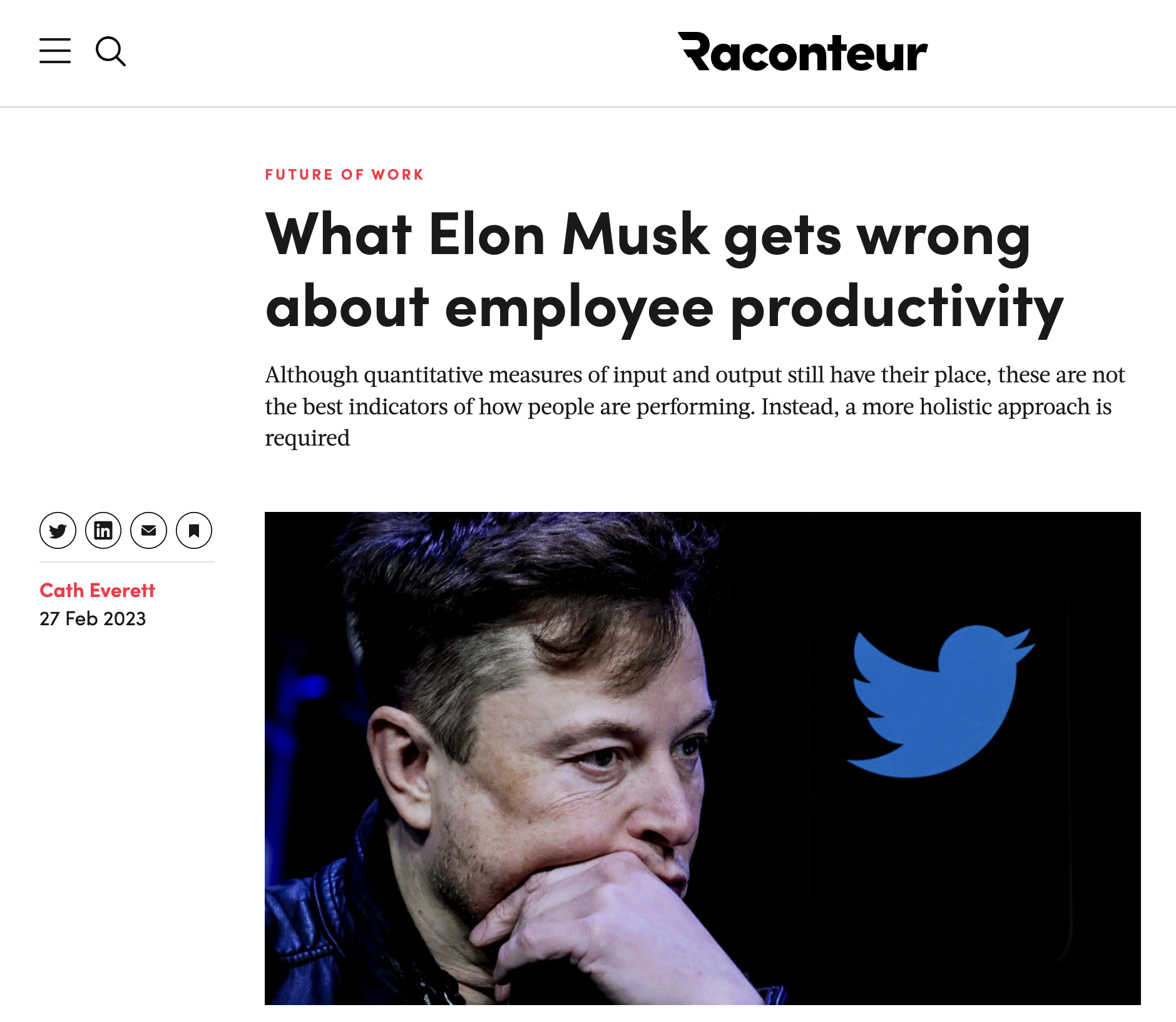What Elon Musk gets wrong about employee productivity
What Elon Musk gets wrong about employee productivity – originally posted for Raconteur
I was thrilled to be interviewed as part of this fascinating article by Cath Everett for Raconteur
Although quantitative measures of input and output still have their place, these are not the best indicators of how people are performing. Instead, a more holistic approach is required

When Elon Musk acquired Twitter last October, he raised eyebrows by demanding that employees commit to making the business “extremely hardcore”. This directive included a stark ultimatum: either work “long hours at high intensity” or leave. There was even talk of programmers being asked to print out everything they had worked on recently, with the number of lines of code they’d written serving as a measure of their value to the company.
Musk is an extreme example of the ‘cult of productivity’ that still pervades many organisations. See also Amazon, which has attracted much criticism for having adopted an automated monitoring system to track the time warehouse workers aren’t spending on their allotted tasks.
The rights and wrongs of workplace surveillance aside, many behavioural experts don’t believe that gauging performance using such coldly mathematical measurements is the best way to get the best from people. Kim-Adele Randall, CEO of change management consultancy Authentic Achievements, is one of them.
“Productivity does have its place as a measure,” she says. “But, if that’s the only one you’re using, it will fail eventually because it’s too constraining.”
One problem with measuring an individual’s performance in purely quantitative terms, such as the number of hours worked or the number of widgets produced, is that it ignores quality. A second is that it can create perverse incentives, prompting people to focus on the wrong outputs.
Measuring the wrong thing – that is, just how busy employees are – causes massive problems, because it doesn’t make people feel valued
“In call centres, for instance, rating employees by the number of calls they complete will drive them to get through those calls as quickly as possible. It means they won’t focus on ‘first contact’ resolution, as that takes too long,” Randall says.
As a result, a customer is more likely to be left unsatisfied by a perfunctory interaction that doesn’t resolve their query on the first call.
A third downside of using quantitative metrics alone is the negative impact this will often have on the people being measured, she adds. “Measuring the wrong thing – that is, just how busy employees are – causes massive problems, because people don’t feel valued. Heaven forbid they miss their performance targets. And at best, all they ever get to be under that system is ‘not wrong’. There is no upside.”
The longer-term result of this practice is that people will tend to burn out under the stress it imposes and, eventually, quit. The organisation’s staff retention rate then declines, as does its performance as experienced workers leave in their droves. In turn, it must spend more on recruiting replacements – and it may find attracting new talent harder if the exodus has harmed its reputation as an employer.
https://raconteur.london/upload/uploads/hype/online-special-report/2023/Future%20of%20Work/FoW_Article01_Chart01.html?initialWidth=700&childId=block_3846d05afa47aecbd0951166ddfabe48&parentTitle=What%20Elon%20Musk%20gets%20wrong%20about%20employee%20productivity%20-%20Raconteur&parentUrl=https%3A%2F%2Fwww.raconteur.net%2Ffuture-of-work%2Felon-musk-employee-productivity%2F
How to introduce more qualitative metrics
The solution seems straightforward enough: use an appropriate balance of quantitative and qualitative metrics, which should be reviewed regularly to ensure that they aren’t encouraging dysfunctional behaviour. Managers at the call centre, for instance, could assess customer feedback in surveys or online reviews, or even listen in on calls to gauge the quality of the service their staff are providing.
A firm’s choice of qualitative measures will send employees an important message about the outputs that really matter to it, says Jeremy Campbell, CEO of business improvement consultancy Black Isle Group.
“Daniel Pink’s 2009 book, Drive: the surprising truth about what motivates us, discusses how mastery, purpose and autonomy are the three intrinsic drivers of productivity and engagement,” he explains.
With these principles in mind, it’s particularly valuable to assess how engaged people are with their organisation’s purpose. Retention rates may be a good indicator of that, but more meaningful insights are likely to come from how employees behave – for instance, call-centre staff taking the time to listen carefully to customers’ queries rather than getting them off the line as quickly as possible.
Campbell also advocates taking more of a “performance coaching” tack. To this end, he recommends breaking down the business year, or individual projects, into 10-week sprints, the success of which is based on hitting clearly defined aims that dovetail with annual goals. Daily activities should contribute to these aims. Performance should be reviewed weekly to identify how the business can best help people to improve – for instance, by offering training where skills gaps exist.
Performance management that works for everyone
Competency frameworks offer an alternative approach, which has been used to great effect by Edinburgh-based software developer xDesign. Indeed, it helped the firm to clinch the top spot in its size category in Great Place To Work’s rankings of the UK’s Best Workplaces in Tech 2022.
These frameworks, which the company created itself, set out the skills required and outputs expected of junior, midweight and senior employees across the business. It ensures that staff at all levels are clear about how best to contribute towards their organisation’s goals. They must also set aside time to establish key performance indicators with their line managers.
Data is a powerful strand, but it’s not the only one. You need to treat each employee like a whole person, not just a productive unit
Timesheets are among the quantitative measures that xDesign uses, although these serve exclusively as resource-planning tools for billable projects. The harder metrics are recorded in a performance management system alongside qualitative measures such as 360-degree feedback and are reviewed regularly to check their ongoing effectiveness. Personal development plans are also an important part of the mix.
“If someone isn’t performing, the competency framework is the thing we go back to,” says the firm’s chief people officer, Ciji Duncan. “It’s how we can see if someone is doing their job effectively – and it enables us to have the necessary conversations.”
Ultimately though, ensuring effective performance from employees requires a “holistic approach”.
“This is an amalgam of several things, but much of it is about ensuring open dialogue and setting clear expectations,” Duncan explains. “Data is a powerful strand, but it’s not the only one. You need to treat each employee like a whole person, not just a productive unit.”
If you enjoyed this, you might like to check out our recent article “the top ten challenges facing leaders today” or our YouTube Channel

